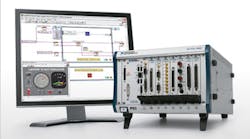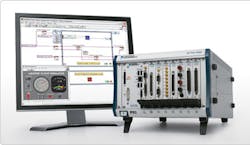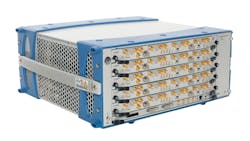Modules Take The Place Of Full-Sized Instruments
Modular measurement systems have gained in respectability and use over the past decade, with most top-level test-and-measurement equipment manufacturers now offering modular versions of different test functions at RF and microwave frequencies. At one time considered lacking in accuracy and repeatability compared to traditional, benchtop instruments, newer instrument modules can typically match the performance of their larger benchtop counterparts, while sliding into a rack-mount mainframe with many other different-function modules.
Related Articles
• Replace Components With A Single Module
• Amp Module Boosts S- And C-Band Signals
• Amplifier Module Drives 6 To 18 GHz
One of the best known companies in modular instrumentation is National Instruments. At the recent 2013 International Microwave Symposium (IMS) in Seattle, WA, the firm announced that it is working with some of the more specialized companies in high-frequency test, with the intent of providing solutions for source and load-pull measurements.
More specifically, National Instruments is using its test signal and analysis hardware and measurement software in combination with companies that design and supply precision load-pull and source-pull tuners capable of varying the impedance shown to an amplifier under test—among them, Anteverta Microwave, Focus Microwaves, Maury Microwave, and Mesuro, The goal is to provide practical measurement solutions for source and load pull characterization requirements placed on microwave power amplifiers for aerospace and defense and wireless infrastructure applications.
According to Steve Dudkiewicz, Director of Marketing and Business Development at Maury Microwave, “Modular PXI products such as the NI vector network analyzer simplify the load pull setup by merging all instruments into a convenient low-cost chassis, which improves overall measurement speed and usability.” He adds that “the system guarantees adaptability as new technologies and modulation schemes emerge because we can add PXI modules ad hoc, and users can modify and script custom load pull sequences using an NI open-source load pull toolkit in LabVIEW.”
Even with the space limitations of a modular measurement format such as PXI, National Instruments has managed to squeeze impressive capabilities into its modules. The NI PXIe-5672, for example (Fig. 1), is a 2.7-GHz vector signal generator (VSG) capable of controlling standard or custom waveforms with real-time bandwidths as wide as 20 MHz across a carrier-frequency range of 250 kHz to 2.7 GHz. The compact signal-generator module operates at a sampling rate of 100 MSamples/s with 16-b resolution and can command output levels from -145 to +10 dBm. Each module is shipped with a version of the company’s NI LabVIEW Modulation Tookkit software; this provides extensive tools for signal generation, signal analysis, signal visualization, and processing of waveforms for commercial, industrial, military, and even medical applications.
1. Built in the PXI format, the model NI PXIe-5672 is a 2.7-GHz vector signal generator with carrier-frequency range of 250 kHz to 2.7 GHz. (Photo courtesy of National Instruments.)
With its 3000 Series of RF Modular Instruments, Aeroflex has extended its PXI modular instruments to signal-generation speeds of 6 GHz and signal-analysis rates to 13 GHz. It supports the modules with its PXI Studio application software for signal generation and vector signal analysis, with large libraries of the type of signal formats found in wireless communications systems, including quadrature-amplitude-modulated (QAM) and phase-shift-keying (PSK) signals.
As an example of its PXI signal generators, its 3010/3011 synthesized PXI signal generators cover a frequency range from 1.5 to 3.0 GHz with 1-Hz frequency tuning and 250-μs frequency switching speed (with Option 01). These modules can operate with internal or external frequency references, achieving impressive phase-noise performance of -116 dBc/Hz offset 20 kHz from the carrier at 2 GHz and -140 dBc/Hz offset 1 MHz from the same carrier. The sources can be equipped for in-phase/quadrature (I/Q) modulation. These synthesized sources deliver as much as +3-dBm output power.
Mini-Circuits, perhaps best known for its RF/microwave components, also has designed and developed numerous portable test instruments with the Universal Serial Bus (USB) interface—including switch matrices and signal generators. The firm’s new model SSG-6400HS USB synthesized signal generator is reviewed in detail in this issue (see p. 90). It has a frequency range of 250 kHz to 6400 MHz and an 85-dB dynamic range that can be set in steps as small as 0.01 dB from -75 to +10 dBm.
The USB Approach
Related Articles
• Replace Components With A Single Module
• Amp Module Boosts S- And C-Band Signals
• Amplifier Module Drives 6 To 18 GHz
High-frequency instrument manufacturers have adopted numerous modular formats based on fitting modules into a mainframe-type chassis, such as AXIe, PXI, and VXI modules, but one modular format has taken off quite nicely even without the aid of “link-to-tradition” mainframe chassis: USB modules. These modules may be as simple as a small package with an input and output and USB port. They operate as stand-alone modules, without need of a plug-in chassis—many without need even of a power supply (in addition to the USB supply).
Companies such as Vaunix Technology Corp. have aggressively developed numerous measurement functions in compact modular form, all of which can be connected to a computer’s USB port and controlled by software on the computer. Vaunix has created modules for such functions as phase shifting and digital attenuation over broad operating bandwidths. The firm’s “Lab Brick” USB-powered test equipment includes numerous models of signal generators in the LMS Series (Fig. 2).
2. The LMS Series of Lab Brick signal generators includes models reaching as high as 4000 MHz. (Photo courtesy of Vaunix Technology Corp.)
The LMS Series of Lab Brick signal generators from Vaunix includes models for use from 70 to 450 MHz, 250 to 1500 MHz, 600 to 3200 MHz, and 1000 to 4000 MHz. The miniature signal generators allow users to select from an internal or external 10-MHz frequency reference oscillator; they can run on just USB power, with no additional battery required. These signal generators do not skimp on performance because of their small size, and can provide as much as +13 dBm output power to 4000 MHz. They tune frequency with 100-Hz frequency resolution and can switch frequencies and output levels with 100-μs switching speed. The signal generators offer phase-continuous linear-frequency sweeping capability, and military testers will be pleased to find that pulse modulation is available as an option.
A company long associated with rack-mount and mainframe instrumentation, Agilent Technologies, has shown that it can do quite well in the modular instrument arena as well. The firm supports a variety of different test module formats, including AXIe, PXI, VXI, and even USB modules. Agilent also offers “LXI: Going Beyond GPIB, PXI, and VXI,” a free-of-charge, 10-page application note (No. 1465-20). The document offers a comparison of various modular measurement formats, with a healthy push for LXI as a format to be considered.
Late last year, the firm introduced its model M9703A eight-channel digitizer based on the AXIe module format (Fig. 3). With its wide-bandwidth, real-time digital-downconversion (DDC) functionality, the digitizer module (and its phase-coherent acquisition channels) is ideal for making measurements in high-channel-count applications, such as in radar, direction-finding (DF), and satellite beam-forming systems.
3. The model M9703A eight-channel digitizer is based on the AXIe module format and operates from DC to 2 GHz. (Photo courtesy of Agilent Technologies.)
The M9703A eight-channel digitizer operates across a frequency range of DC to 2 GHz with a sampling rate of 1.6 GSamples/s. It includes tuning and zooming capabilities to precisely set center frequency and bandwidth, as well as real-time decimation capabilities for tight control of dynamic range. The digitizer module is compatible with the firm’s 89600 Vector Signal Analysis software for advanced measurements, such as signal analysis and demodulation, under software/automated control.
4. This five-slot AXIe chassis holds five M9703A AXIe 12-b digitizers to form a 40-channel acquisition system. (Photo courtesy of Agilent Technologies.)
This AXIe digitizer module, when combined with one of the company’s two-slot or five-slot AXIe chassis, allows users to scale the number of parallel acquisition channels without the use of switches, reaching as many as 40 signal-analysis channels in only 4U of rack-mount space with five AXIe M9703A digitizers (Fig. 4). Such a measurement system allows simultaneous acquisition of data on a large number of channels under dynamic conditions, reducing test and calibration time.




